| Reviews & Columns |
|
Reviews DVD TV on DVD Blu-ray 4K UHD International DVDs In Theaters Reviews by Studio Video Games Features Collector Series DVDs Easter Egg Database Interviews DVD Talk Radio Feature Articles Columns Anime Talk DVD Savant Horror DVDs The M.O.D. Squad Art House HD Talk Silent DVD
|
DVD Talk Forum |
|
|
| Resources |
|
DVD Price Search Customer Service #'s RCE Info Links |
|
Columns
|
|
|
Humphrey Bogart - The Signature Collection, Vol. 2
THE MOVIES:
"Nazis make swell heavies." - Walker McEwen, production assistant to Hal Wallis on All Through the Night
The Humphrey Bogart Signature Collection, vol. 2 is kind of a strange package. The new 3-disc Maltese Falcon is clearly intended as the hook to get you to buy the box, but this new mega-release of the classic film is the odd man out among the other new releases. The four films Falcon is housed with are all wartime propaganda vehicles made between 1942 and 1944, with Bogart doing his part as a member of the war effort. It's certainly not a bad collection of films--in fact, they are all very good--but it doesn't achieve the unified feeling vol. 1 has (though, that one brings together previously released material, so there are caveats on both sides).
Then again, I don't see much downside for Bogart fans. If you aren't buying this for Humphrey, if you're just a film noir buff or a fan of the Dashiell Hammett adaptation, then you can purchase the Falcon set on its own. (It's three discs, including three different adaptations of the crime novel.) If you love Bogart, then you are most likely going to want both the Falcon upgrade and the new releases, so the Signature Collection, vol. 2 is a convenient way to score them all and get down with Bogie to your heart's content.
I am going to cover each disc in the box in chronological order, and rather than discussing the extras at the end of the review like I'd normally do, I'll note what the DVDs contain as I go. Each of the discs in the Humphrey Bogart Signature Collection, vol. 2 is packed with bonus features. I'm a big fan of the "Warner Night at the Movies" option that Warner Bros. puts together for its classic films. In an attempt to recreate what it was like to see these movies in the theatre, these discs each have a period trailer for another WB movie, a newsreel, a live-action short subject, and a cartoon. You can choose to watch any of those items on their own, or you can use "play all" to run through the lead-in features and then on into the main picture without stopping.
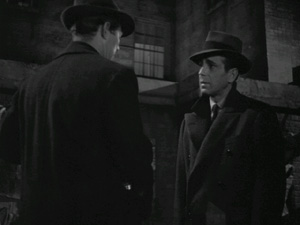
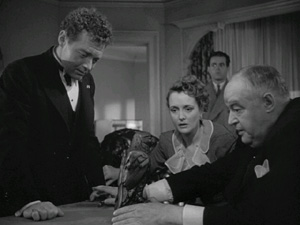
* The Maltese Falcon (1931/1941) & Satan Met a Lady (1936): I've seen the '41 version of The Maltese Falcon more times than I can count and read the Dashiell Hammett novel at least twice; however, I had never seen the other two versions before this. I thought it would be fun to watch them in order and see how the story climbs up the ladder. How many Sam Spades and bands of thieves does it take to catch a priceless bird?
Sometimes known as Dangerous Female, Roy Del Ruth's 1931 adaptation isn't a bad film, but it does have the clunkiness of early Hollywood. The story is essentially the same as its more famous descendent--private dick Sam Spade is hired by a dazzling dame to chase after a pack of lies, leading him into a nest of crooks all searching for a fabled jewel-encrusted statue of a bird--but without any of the hardbitten dialogue. What really sets the two apart, however, are the actors. Ricardo Cortez, who would also later play Perry Mason in The Case of the Black Cat, doesn't really pull off Sam Spade. He's a little too flip, trading on his sarcastic Cheshire cat grin rather than commanding the room. If he were under the gun with John Huston's villainous 1941 cast, he'd never get out alive. Thankfully for Cortez, the band of thieves he must contend with aren't nearly as sinister. The only actor who comes close to achieving the same level of menace is Dudley Digges. As Gutman, he manages the arch façade of the criminal mastermind. The homosexual undertones between himself and Wilmer (Dwight Frye, who was Renfield in Dracula) is also easier to read than you'd expect for the time period, as is most of the story's sexuality. The problem is that the film just isn't tough enough, something that is all too evident in the climactic confrontation between Spade and Ruth (Bebe Daniels, 42nd Street). Sam's womanizing is so exaggerated in the early scenes, and his interaction with his partner Archer (Walter Long) so cold, it's hard to believe he would be all that concerned with the man's death, an essential part of the story.
One thing Del Ruth does have that is not in the 1941 film is a coda where Spade visits Ruth one last time. It's actually the one scene where Cortez's take on Sam really works, as he begins the scene with humility and sadness and ends by covering up those emotions with the same rakish smile. It's what he'd been shooting for all along, but unfortunately for him, he only managed to snag it in the last two minutes.
1936's Satan Met A Lady shares only a superficial resemblance (and one screenwriter, Brown Holmes) with the previous film. Sam Spade becomes Ted Shayne (Warren Williams, from the 1934 Imitation of Life), a gadabout private detective whose only sleuthing skills are finding gullible marks among rich widows. Run out of the town he had been hanging his shingle in, he returns home to annoy his old partner Ames (Porter Hall) and make woo with the man's wife (Wini Shaw). It's an easy gig until big money comes his way, a wad of cash by the name of Valerie Purvis (Bette Davis). Purvis' trumped-up case gets Ames shot, and when she comes clean, she asks Shayne to find a jewel-filled horn once owned by the legendary French soldier Roland. Competing for this trumpet is a tall Englishman Travers (Arthur Treacher as the stand-in for Cairo) and Madame Barabbas (Alison Skipworth as a female Gutman). The tone here is more comedic, and Hall plays Shayne with a droll wink. It's amusing as it goes, and it features many of the same double-crosses as the more famous adaptations of Hammett's novel, but it's only a slight diversion. Davis comes and goes in the movie, only occasionally showing hints of the talent that earned her reputation. A fun inbetweener, nothing more.
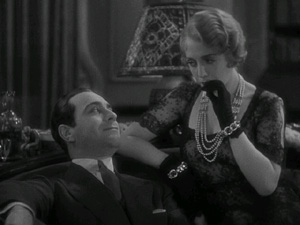
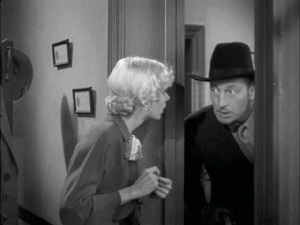
Sam Spade in 1931 and 1936
The true classic comes with John Huston's faithful 1941 retelling. Sticking as close as possible to the Hammett text while still translating it to film language, Huston's Maltese Falcon proved to be the breakout role for Humphrey Bogart and one of my favorite all-time films. Much has been said over the years about The Maltese Falcon, and there isn't really more to add. Just know that this movie needs to be in your collection. Its stylish angles, snappy pace, and crisp dialogue brings the story to life in a way few other hardboiled adaptations can match. Only 100 minutes long, you'd swear far more happens than the space can contain, but the editing and the camera keeps the story moving. Bogart does everything with Spade that Ricardo Cortez could not ten years before. He wears his cynicism as casually as his finely tailored suit. He is at once manipulative, humorous, and seductive, and yet beneath it all, he is honorable. Bogart makes Spade the ultimate example of an existential hero in the first half of the 20th century.
Yet, Bogart couldn't do it alone. Huston has cast the picture to give him a supporting cast that is just as interesting as the lead. If we weigh the scales on darkness and eccentricity, then we might even call them more interesting. Peter Lorre is the dandified, oily Cairo, while Sydney Greenstreet makes a formidable film debut at the age of 61 as the malevolent benefactor, Gutman. Mary Astor is both frail and dangerous as the femme fatale, while Elisha Cook Jr. is blood curdling as the quietly explosive Wilmer and Lee Patrick provides a real world counter balance as Spade's longsuffering secretary. Even the most minor of roles is given the utmost attention, ensuring that Huston and Hammett's meticulously constructed underworld is as full and rich as it deserves to be.
DVD 1 has the "Warner Night at the Movies" feature, where you will see a trailer for Sergeant York (though, strangely, pillarboxed on the screen) and a newsreel featuring a meeting between Churchill and FDR (though with really bad audio). Much better is the Technicolor musical short "The Gay Parisian," an extended dance performance that is bright and beautiful. Two cartoons finish it off, the color Bugs Bunny short "Hiawatha's Rabbit Hunt" and the black-and-white Porky Pig selection "Meet John Doughboy." The sound is so bad on the latter it's nigh unwatchable. The music was much louder than the dialogue, which was muffled and way to the back. To turn up the cartoon so it was loud enough to hear the dialogue meant the music would blast me out of the room.
Additionally, the first disc has a full-length commentary on The Maltese Falcon by Bogart biographer Eric Lax. Lax sheds light on all aspects of production, and also gives background information on the actors in the film. It's quite interesting and makes for an expanded viewing experience.
DVD 2 has the extra movies, as well as a trailer for Satan Met a Lady.
DVD 3 is the designated bonus disc. It has the same feature as on the original DVD of The Maltese Falcon, a Turner Movie Classics show called "Becoming Attractions: The Trailers of Humphrey Bogart." Hosted by Robert Osborne, it charts Bogart's fame by how he is represented in trailers for some of his touchstone films. This old documentary is joined by a new one, the half-hour long "The Maltese Falcon: One Magnificent Bird." It's a discussion of the lasting impact of the movie, and it features critical commentators like Peter Bogdanovich and Eric Lax; actors like Henry Rollins and James Cromwell; writers Frank Miller (Sin City), Larry Cohen (Phone Booth), and Christopher McQuarrie (The Usual Suspects); cinematographer Roger Deakins (The Man Who Wasn't There); and Dashiell Hammett's granddaughter. It's a pretty good program, packing a lot of detail.
A Mary Astor make-up test, lasting about a minute and a half and without sound, is also included, alongside the 1941 Warner Bros. blooper reel (including a couple of swearing scenes from Bogie, and a lot of James Cagney). Finally, there are three different radio versions of The Maltese Falcon, two with the movie's cast and one with Edward G. Robinson.
Movie: 5 stars, Disc: 5 stars
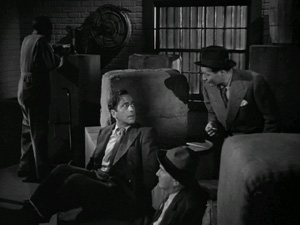
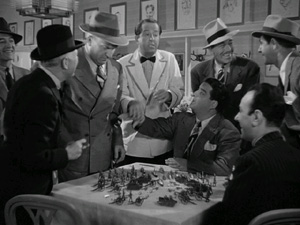
* All Through the Night (1942): In this wartime send-up, Bogie plays Gloves, a too-cool gangster with his hands in everyone's cheesecake. When his favorite baker goes missing, Gloves' mother (Jane Darwell, The Devil & Daniel Webster) gets worried and asks her baby boy to investigate. Before he knows it, Gloves is up to his neck in murders and Nazis.
Directed by Vincent Sherman (The Damned Don't Cry), All Through the Night gets a little too rah-rah in its second half, when the normally selfish Gloves joins the war effort and gets all of his underworld pals to join in, but the movie stays fun thanks to a relentless comedic pace and a tremendous supporting cast. Gloves' crew is massive with comic legends like Phil Silver, Jackie Gleason, and William Demarest. The bad guys are also as bad as the crooks are funny. The two main Nazis are played by Bogart's future Casablanca co-stars Peter Lorre and Conrad Veidt. The climax, with Bogie stopping Veidt from blowing up a docked battleship in the New York harbor, is definitely over the top, but it's still a blast, both literally and figuratively.
The "Warner Night at the Movies" starts with a trailer for the Errol Flynn boxing picture Gentleman Jim. With its many references to manliness and "gay San Francisco," you have to wonder if it was chosen for its camp value. The newsreel is about an ocean tanker being attacked by a Nazi U-boat, and the Jon Doakes comedy short is a funny "instructional" called "So You Want to Give up Smoking." Finally, the cartoon "Lights Fantastic" is a Warner Bros. short using neon signs as springboards for gags and musical numbers.
Other features include a new documentary entitled "Call the Usual Suspects: The Craft of the Character Actor." It features authors/critics and modern day character actors like Bruce Davison (X-Men), Edie McClurg (Ferris Bueller's Day Off), and Clint Howard (every Ron Howard movie) discussing the people who make the scenes come alive in picture after picture. James Cromwell (L.A. Confidential) makes one of the more interesting points, that the character actor is intended to represent the audience. Not everyone can be a Humphrey Bogart, most of us are Paul Dooleys (the father in Sixteen Candles). Of course, some of the frequent Bogart repertory are profiled, like Peter Lorre, Sydney Greenstreet, and my favorite fall guy, Elisha Cook, Jr.
The feature-length commentary is by director Vincent Sherman and Bogart biographer Eric Lax. Lax provides intricate information on the performers in the film and the history of the production, whereas Sherman gets into day-to-day production stories. It's a good commentary with lots of fascinating anecdotes. Lax informs us that Sherman was 99 when his part was recorded earlier this year, and his vivacious demeanor makes him marvelous to listen to. Sadly, he passed on this summer before he could see this DVD come to pass.
Movie: 3.5 stars, Disc: 4.5 stars
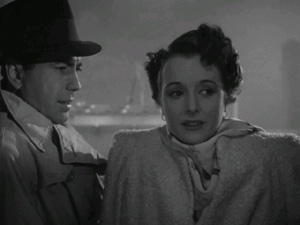
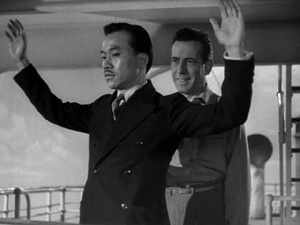
* Across the Pacific (1942): This film is notable as a follow-up of sorts to The Maltese Falcon. Directed by John Huston, it reunites Bogart with Mary Astor and Sydney Greenstreet in an espionage story set just before WWII. Bogart is Rick, a disgraced soldier who falls in with a bad crowd on a Japanese freighter heading down to the Panama Canal. Greenstreet plays Lorenz, a cold businessman who is looking to make a killing in the Philippines and claims he is against a war with Japan because it will hurt his profit line. The closer they get to the Canal, however, the more Lorenz reveals. He's got something else cooking, and he's willing to pay handsomely for Rick's knowledge of the Canal. To complicate matters is the romance between Rick and Alberta (Astor), who claims to be a hayseed from Canada but may have a backstory that goes deeper. Which, really, they all do--Rick is running a game, too, but he's on the side of the good guys.
Across the Pacific is one of Hollywood's most straightforward war efforts, tickling paranoia about spies hiding among us. Its climax is set the day before Pearl Harbor, and in a weird case of clairvoyance, the original screenplay by Richard Macaulay (from a magazine serial by Robert Carson) initially hinged on the Japense attacking that very spot in Hawaii. When the tragedy really did happen, the script was retooled to climax in a Japanese plot against the Panama Canal, which is something that Bogart could actually be shown stopping. Lorenz and his undercover cronies were hoping to catch America with their pants down, but at least in this pocket of the fictional universe, that wasn't going to happen. Bogart and Astor have more fun in their romantic subplot than in The Maltese Falcon, giving their on-ship banter a sillier spin. Rick's jib is cut similar to Sam Spade's in that much of his swagger swings on him fostering an illusion of self-centered ambivalence. When the chips fall, however, Rick is allowed to be more of a hero, busting heads in the jungle and commandeering a machine gun. Some of the action is a little clunky, possibly down to John Huston leaving before shooting finished to join the war effort (Vincent Sherman took over), but the trio of great actors makes Across the Pacific more than worthwhile.
For Extras on Across the Pacific, Warner Brothers has made a new documentary called "Hollywood Helps the Cause," with current filmmakers and critics discussing how Tinsel Town banded together with the U.S. government in order to make films that helped the international campaign. It's a good little featurette, though maybe a little too shiny with nostalgia. There is also a studio blooper reel from 1942 with a couple of funny moments. Some of the jokes concocted with editing feel a little dated.
The "Warner Night at the Movies" element has a trailer for the Jimmy Cagney fighter pilot movie Captains of the Clouds, a wartime newsreel, a rather dull color short called "Men of the Sky" meant to rouse patriotic fervor in praise of the air force, and a Looney Tune called "The Draft Horse" that is really quite funny. A regular farm horse sees that the army needs horses, goes down to enlist, and then proceeds to annoy the officer on duty.
Movie: 3 stars, Disc: 4 stars
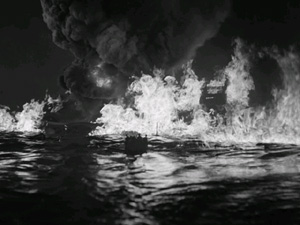
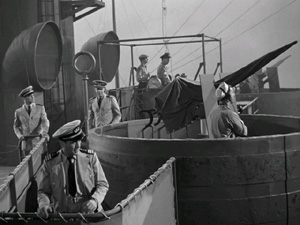
* Action in the North Atlantic (1943): This Lloyd Bacon (It Happens Every Spring) picture doesn't waste any time getting started. A Merchant Marine ship carrying fuel for overseas troops is attacked by a German submarine. Jumping through fire and dodging explosions, the men of the ship make their way to the lifeboats. Led by Captain Jarvis (Raymond Massey, Arsenic & Old Lace) and Lt. Joe Rossi (Bogart), most of them get out alive. As their ship sinks and the ocean burns, the U-Boat turns on them, destroying their lifeboat and forcing them to float on a bare raft for a week and a half. That's a long time to think about getting your vengeance.
The survivors aren't back on dry land very long before they receive a new assignment. Only one of them, Pulaski (Dane Clark, Destination Tokyo), even thinks of staying home, but once the other guys get through browbeating him, he gladly accepts his duty. It's up to the Merchant Marines to make sure the rest of the fighting forces get their weapons, so if guys like Pulaski pull out, who will take care of business? The crew's new cruiser, The Sea Witch, is loaded up with planes and other equipment, and they now also have a Navy gunner crew to provide protection. The freighter joins an international convoy of ships on their way to Russia for added muscle, but the journey will be fraught with peril and eventually the Witch will be on its own, squaring off with a Nazi U-boat so the old crew can exact its revenge for their lost mates.
Action in the North Atlantic has two major things going for it. The first is the camaraderie of the men. Scenes down below deck between the sailors provide moments of lightness. The crew plays cards and ribs one another. Alan Hale, known for his regular roles as Errol Flyn's sidekick, is particularly funny as Boats, a womanizer who goes to sea to escape his alimony payments. Bogart is the definite star, however. In what is his usual turn, Rossi begins the picture as a man who is only in it for himself. Yet, after the tragedy, he ends up marrying a pretty saloon singer (Julie Bishop, Northern Pursuit) and realigning his priorities. Though he insists he doesn't ever want to captain his own ship, as he is not fond of responsibility, viewers will know right away exactly what is going to happen to Joe: he's going to prove he has more mettle than he gave himself credit for.
The second major attribute of Action in the North Atlantic is the battle scenes. Special effects shots are spliced together with documentary footage of real boats and planes. Though I'm sure some models were used, Bacon has shot the movie so that it's not obvious what is real and what is not. The action is exciting, and some of the death scenes, particularly down in the submarines, are harrowing. The tension and danger of the fighting makes the rush to Russia all the more electrifying.
For the "Warner Night at the Movies," there is a trailer for Nothern Pursuit, newsreel footage of the real Navy engaging in aerial battle, a short film about the history of dancing in America ("Cavalcade of Dance," starring Veloz and Yolanda), and a Merrie Melody called "Greetings Bait," starring a worm modeled after comedian Jerry Colonna who invents all sorts of ingenious schemes to catch the fisherman his fish.
Other bonuses are a vintage radio production of Action starring George Raft and Raymond Massey, and a new documentary called "Credit Where Credit is Due." The radio show has an imperfect audio quality, but good enough. The documentary is informative, looking at some of the unsung behind-the-camera people in the studio system. That includes directors Lloyd Bacon and Vincent Sherman, who for various reasons never cultivated the kind of public face worn by the likes of John Huston.
Movie:4 stars, Disc: 4.5 stars
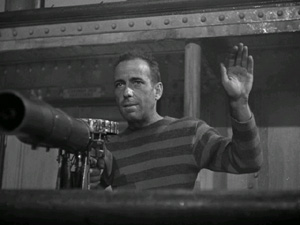
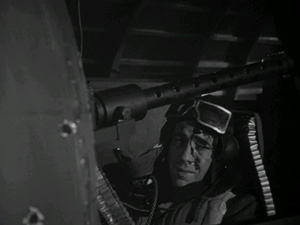
* Passage to Marseille (1944): As Across the Pacific was a bit of a reunion of the principles from The Maltese Falcon, this fantastic wartime picture brings together many of the players from Casablanca: Bogart, Peter Lorre, Sydney Greenstreet, Claude Rains, and director Michael Curtiz.
I would call Passage to Marseille the real surprise of this set. Screenwriters Casey Robinson and Jack Moffit, adapting a novel by Charles Nordhoff and James Norman Hall, have created a complex story about the Free French Air Corps, a squadron of French patriots who escaped the Nazi-occupied country to carry out operations from a secret base in England. The tale is constructed as a series of narratives within the main plot. A reporter visits the farm where the squadron sets up shop, hiding their planes in barns and their equipment under haystacks. Captain Freycinet (Rains) begins to explain to him how the group came to be, but instead he veers off into an off-the-record story about five soldiers who he encountered while sailing the ocean on his way to Marseille with supplies. The boat picked up a canoe full of men who, as it turns out, are convicts who escaped from Devil's Island to enlist in the French army to fight off the Nazis. The men explain to Freycinet how they came to their predicament, and the story of their escape also includes the story of Jean Matrac (Bogart), the leader of this small band who had been a crusading reporter in France in the period before the war when the Germans were starting to move in. For daring to speak out against his country's capitulation to foreign powers, he was sent to the prison colony on trumped-up charges, forced to leave his new wife (Michéle Morgan, The Fallen Idol) and the ideals he once held dear.
By the time Matrac ends up on the boat returning to France, he has lost faith in his nation and is lying when he says he is willing to fight for it. Through attacks by the self-important French officer Major Duval (Greenstreet) and a Nazi fighter plane, Matrac rediscovers what made his patriotism so important. Before they reach Marseille, however, the crew learns that the Nazis have taken over the country and so divert their course to England rather than give the enemy their cargo. This takes us back to the farm and the reporter, and an ending that is cynically realistic while stoking the flames of patriotic pride.
Passage to Marseille is an awesome film. Curtiz has complete control of his production, never losing his audience no matter how far into the flashbacks he goes. Bogart is hard-edged while also being heroic, and his now familiar compatriots back him up excellently. Lorre displays particular relish as the pickpocket Marius, slyly fetishizing his own crimes while staying true to the bond between his fellow escapees. The action scenes on the boat are exciting and violent, and the hidden headquarters of the Free French Air Corps is cleverly put together. Passage to Marseille naturally doesn't rate as high as its more famous predecessor, but it does prove that Curtiz and Bogart could beat the odds and capture lightning together more than once.
Passage to Marseille has a new short documentary called "The Free French: Unsung Victors," examining the political climate that fueled the real-life soldiers that inspired the movie. Far less serious is the 1944 Warner Brothers blooper reel, and it's a lot funnier than the other blooper reels in the set, as it has more authentic mistakes and less jokes constructed with editing.
This DVD's "Warner Night at the Movies" runs nearly 40 minutes. It begins with the trailer for Uncertain Glory and follows with a somewhat cheeky newsreel about female Marines. "I Won't Play" is an Oscar-winning short film starring Dane Clark as a bigmouthed piano player who annoys his fellow soldiers out on the front with his bragging about being in showbiz. When the entertainment-starved troopers get hold of a piano, Clark refuses to play, and the rest of the guys think they finally have proof that he is lying. Little do they realize that all the proof required to know for sure is on the next plane.
"Jammin' the Blues" is a gorgeously shot jazz performance with three different songs and even some dancing. The music is excellent, and the black-and-white compositions are elegant (though, with such a meticulously planned film, it doesn't lend much credence to the claim that it's a real jam session). Finally, before Passage to Marseille, we get the cartoon "The Weakly Reporter," a parody of newsreels that strings together a succession of timely gags about wartime hardships.
Movie: 4 stars, Disc: 4.5 stars
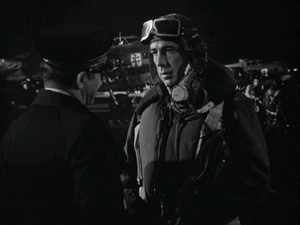
Average Movie Score: 4 stars, Average Per-Disc Score: 4.5 stars
THE DVD
Video:
All of the movies in the Humphrey Bogart Signature Collection, vol. 2 are full frame, and Warner Bros. has done a very nice job of cleaning them up. All the films have occasional scenes that aren't perfect, particularly when using documentary footage to augment the action, but any glitches are rare. Vintage bonus features aren't given the same care as the movies, but I think the studio can be forgiven for not expending a lot of money to scrub down a two-minute newsreel. On the other hand, for the bonus films in the Maltese Falcon set, you can tell that not as much effort was put into restoring them. Some scenes look as fresh as if they were shot yesterday, but a few are pretty ragged. Even so, the main Falcon feature is one of the most gorgeous DVD jobs I've ever seen, and the improvement over the old DVD transfer is immediately obvious.
Sound:
The movies don't have any fancy sound mixes, but the audio tracks are clean. These films weren't intended to be heard in 5.1, so a straightforward mix is all that is required. Strangely, though, on several of the DVDs, the English subtitles came on automatically when I played the main feature. (There are also French and Spanish subtitles.) Not sure if that was an anomaly with my player or not.
Extras:
One thing that I did not note in my reviews of each disc is that they all have vintage trailers for the main feature on their respective discs.
The DVDs are packaged in slimline cases and they come in the standard Signature Collection cardboard box. I am not sure if this was just a problem with mine, but the box seems too big for the DVDs. The Maltese Falcon comes in two cases, one for the movie and one that holds both bonus discs.
FINAL THOUGHTS:
DVD TALK COLLECTOR SERIES. The Humphrey Bogart Signature Collection, vol. 2 is an exceptional collection of films. Though the theme of the bulk of the films differs from the champion of the set (The Maltese Falcon triple disc), it really doesn't matter, because the true feature is Humphrey Bogart himself. His popularity lasts to this day thanks to his rugged portrayals of conflicted men struggling to do the right thing. Whether playing a private detective, a gangster, or a soldier, he has a commanding presence. This boxed set represents some of his best work from the '40s, and together they are a winning combination.
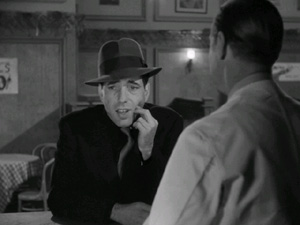
Jamie S. Rich is a novelist and comic book writer. He is best known for his collaborations with Joelle Jones, including the hardboiled crime comic book You Have Killed Me, the challenging romance 12 Reasons Why I Love Her, and the 2007 prose novel Have You Seen the Horizon Lately?, for which Jones did the cover. All three were published by Oni Press. His most recent projects include the futuristic romance A Boy and a Girl with Natalie Nourigat; Archer Coe and the Thousand Natural Shocks, a loopy crime tale drawn by Dan Christensen; and the horror miniseries Madame Frankenstein, a collaboration with Megan Levens. Follow Rich's blog at Confessions123.com.
|
| Popular Reviews |
| Sponsored Links |
|
|
| Sponsored Links |
|
|
| Release List | Reviews | Shop | Newsletter | Forum | DVD Giveaways | Blu-Ray | Advertise |
|
Copyright 2024 DVDTalk.com All Rights Reserved. Legal Info, Privacy Policy, Terms of Use,
Manage Preferences,
Your Privacy Choices | |||||||













